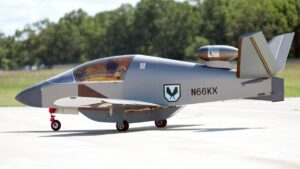Last week we told you about the top U.S. cities best suited for passenger drones. But what about the top cities for European passenger drones?
Just as the U.S. had some clear standout cities — due to factors including terrain, regulatory environment and impact — Europe has some prime zones that could be best suited for unique, innovative aircraft including human-carrying drones.
The picks for top cities for European passenger drones comes from Lufthansa Innovation Hub, which is the research arm of the German air carrier. To name the most viable global cities for launching Advanced Air Mobility (AAM) operations, they teamed up with V2Air, Roland Berger and Unisphere.
AAM is a wide-ranging term that covers refers a broad category of innovative aircraft including, yes, passenger drones.
Passenger drones could prove particularly valuable in a few situations including travel through cities that are otherwise congested on the ground (or just have impractical road blockers like bodies of water). They might even fly outside of cities, covering distances between cities that are too close to each other to justify a traditional airplane ride, but far enough away that a drive would be annoyingly long.
Lufthansa Innovation Hub and its partners used June 2024 data to analyze 26 major European cities. From there, it ranked those cities based on factors critical in launching viable operations of European passenger drones. Those factors included:
- Geographical terrain (tall structures and natural obstacles could present greater hazards)
- Airspace
- Authority (including regional aviation legislation and local initiatives supporting technological development)
- Weather
- Aviation infrastructure and area impact
- Time savings (how efficient ground-based vehicles and public transport currently are)
Cities were then given a feasibility score, which consists of:
- 25% terrain
- 25% airspace
- 50% authority
They also received a viability score, consisting of:
- 25% weather
- 25% area impact
- 50% time savings
Among the major European cities that had high feasibility but low viability were:
- Brussels
- Copenhagen
- Dublin
- Frankfurt
- Helsinki
- Istanbul
- Stockholm
Of the major European cities that had high viability but low feasibility were:
- Barcelona
- Cologne
- London
- Manchester
- Monaco
- Nuremberg
- Rome
- Stuttgart
- Zurich
Meanwhile, Amsterdam, Athens, Lisbon and Madrid didn’t score particularly well on either metric — so don’t expect passenger drones in those European cities anytime soon.
The cities best suited for European passenger drones
But which cities scored well in both feasibility and viability? Four cities stand out: Berlin, Hamburg, Munich and Vienna. Three of the four — Berlin, Hamburg and Munich — are in Germany. And unsurprisingly, Germany is considered one of the hottest hubs for drones in general. Vienna is a neighbor over in Austria.
Vienna is home to a UTM (unmanned traffic management) company called Frequentis. They have long been building communication and information systems for control centers that demand safety-critical tasks. And with the rise of drones, building a UTM solution has become a natural fit for Frequentis. The company has a 30% market share in voice communication systems for air traffic control.
Vienna stood out particularly for its favorable airspace environments. What’s interesting about Vienna is it does have restricted military airspace. But, the routes are designed in a manner that they are easy to navigate around. That said, Monaco and Vienna also scored fairly highly for have “clean” route configurations.
Over in Germany, we’ve also already seen strong drone adoption already. In 2022, Germany’s national railway company, the Deutsche Bahn, announced it was adopted drones for monitoring railway infrastructure and maintenance. It’s working with Pix4D Germany on the project.
Germany is home to Interaerial Solutions, which is one of the world’s largest drone conferences around geoinformation.
Other standout contenders for European passenger drones
Though the following cities didn’t score highly on both the feasibility and viability metrics, some cities did still stand out for dominating certain categories. Some of those highlights are:
Amsterdam: Amsterdam is famous for its waterways, as canals line the city. It’s also quite flat. Given that, the city in The Netherlands ranked highly for terrain suitability. Flatter terrain means fewer vertical ascents and descents. Less up and down motion means aircraft consume less energy, which in turn means that they can fly longer flight routes, or can get turned around faster without spending too much time recharging. That options more route possibilities for passengers — and opens more revenue opportunities for operators.
Paris: Paris has something big going for it, and that’s strong support from the local government. That’s critical, as local government support can likely lead to better partnerships, funding opportunities and support for pilot projects.
Paris is the site of what’s called the “Paris-Saclay Autonomous Lab” project, which develops and tests autonomous air transportation systems in the area. There’s also a big testing ground over at the Pontoise Cormeilles airfield. And, a group called Re:Invent Air Mobility also studies drones.
Which European city would you most like to see passenger drones operate in? Leave a comment below!
The post These 4 European cities are best suited for passenger drones appeared first on The Drone Girl.







